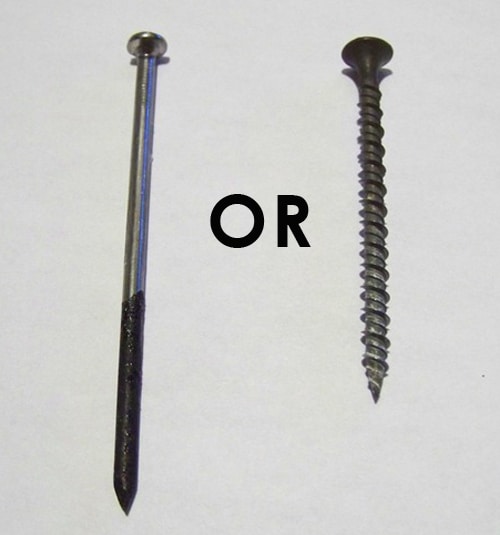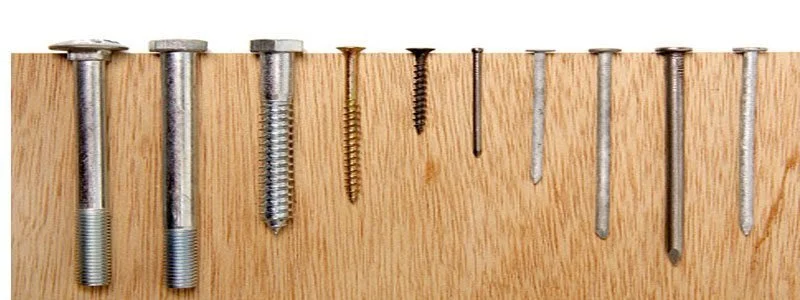When it comes to framing your next project, you might wonder: should you use screws or nails? This choice can make a big difference in the strength, flexibility, and durability of your build.
You want your frame to hold firm through shifting, settling, and even extreme weather—but which fastener will give you that peace of mind? You’ll discover why nails are often the go-to for framing, how screws fit into the picture, and what factors you should consider to get the best results for your construction needs.
Keep reading to find out which option will make your framing stronger and smarter.
Nails Vs Screws In Framing
Choosing between nails and screws for framing impacts a building’s strength and durability. Both fasteners serve specific roles in construction. Understanding their behavior under stress helps select the right one for framing tasks. This section compares nails and screws focusing on flexibility and shear strength, two key factors in framing.
Flexibility And Movement
Nails bend when the building shifts. This flexibility allows them to absorb movements without breaking. Screws are rigid and prone to snapping under pressure. Wood expands and contracts with temperature and moisture changes. Nails accommodate this natural movement better than screws. This reduces damage and maintains structural integrity over time.
Shear Strength Comparison
Shear strength measures resistance to forces sliding parts past each other. Nails excel in shear strength, making them ideal for framing. Screws have lower shear strength and may fail under heavy lateral loads. Strong shear resistance keeps walls and frames stable during wind or earthquakes. Nails’ ability to resist these forces helps prevent structural failure.
Installation Efficiency
Installation efficiency plays a key role in framing projects. Choosing the right fastener impacts the time and cost of construction. Both screws and nails have distinct advantages and drawbacks in this area. Understanding these differences helps builders complete jobs faster and within budget.
Speed Of Application
Nails offer quicker installation, especially with a nail gun. This tool drives nails rapidly, reducing manual effort. Screws require more time as each one must be driven individually. Using a drill slows the process compared to a nail gun. Nail guns speed up framing and lower labor time. This efficiency is vital for large projects with tight deadlines.
Cost Considerations
Nails generally cost less than screws in bulk. This price difference adds up in big framing jobs. Besides the fastener price, tool costs matter. Nail guns are often cheaper and easier to maintain than power drills for screws. Lower tool and fastener costs make nails a budget-friendly choice. This helps contractors keep projects profitable without sacrificing quality.
Durability Under Stress
Durability under stress is vital for framing fasteners. The frame of a building faces constant forces from wind, weight, and settling. Fasteners must handle these forces without failing. Nails and screws react differently to stress. Understanding these differences helps choose the right fastener for framing.
Bending Vs Breaking
Nails bend when the frame shifts. This bending allows the wood to move slightly without damage. Screws, in contrast, tend to break under similar stress. Their rigid structure does not allow much give. Broken screws can weaken the frame and cause costly repairs. Nails provide a flexible hold that supports long-term stability.
Performance In Environmental Changes
Environmental changes cause wood to expand and contract. Nails adapt well to these movements due to their ability to flex. Screws hold tightly but may loosen or snap as wood moves. Moisture, heat, and cold all affect framing materials. Nails maintain grip and strength despite these changes. This makes nails more reliable in varied climates and conditions.
When Screws Are Preferred
Screws are chosen over nails in framing when strength and precision matter. Their unique design offers better grip and holding power. Screws do not loosen easily, making them ideal for certain tasks. They provide a solid, lasting bond in places where movement is minimal. This section explains when screws are the better option for framing projects.
Specialized Structural Screws
Specialized structural screws offer high strength for critical framing joints. They resist pull-out forces better than regular nails. These screws are designed to handle heavy loads and stress. Builders use them in areas requiring extra support and safety. Their precision threading increases connection stability in wood framing. Structural screws provide a reliable alternative to nails for key framing points.
Uses In Drywall And Cabinetry
Screws are preferred for attaching drywall to wood or metal studs. They hold drywall panels tightly without damaging the surface. Screws reduce the risk of drywall popping out over time. In cabinetry, screws provide a strong hold for drawers and shelves. Their pull-out resistance keeps cabinets secure and durable. Screws allow for easy adjustments or repairs in finished work.
Tools And Techniques
Choosing the right tools affects framing quality and speed. Understanding tools and techniques helps builders work smarter. Different tools suit nails or screws differently. Proper technique ensures strong, lasting frames.
Nail Guns Vs Screwdrivers
Nail guns drive nails quickly and with less effort. They speed up framing, especially on large projects. Screwdrivers, manual or powered, insert screws more slowly. Screws require more precision to avoid splitting wood.
Nail guns reduce fatigue and improve consistency. Screwdrivers offer better control for delicate work. Using a nail gun needs safety precautions to prevent accidents. Screwdrivers allow easy removal or adjustment of fasteners.
Best Practices For Framing
Always choose the right fastener for the material and job. Use nails with nail guns for quicker, flexible framing. Use screws when strong holding power is essential.
Pre-drill holes for screws to prevent wood from cracking. Keep fasteners straight to avoid weakening the frame. Check alignment often to maintain a square structure.
Wear protective gear during installation. Inspect tools regularly to ensure safe operation. Proper fastening improves the building’s strength and durability.

Credit: mosbybuildingarts.com
Cost-benefit Analysis
Choosing between screws and nails for framing involves weighing costs against benefits. This analysis helps decide which fastener suits your project budget and timeline. Understanding material expenses and labor impact guides smart decisions.
Each option affects overall cost differently. Screws may cost more upfront but offer certain advantages. Nails tend to be cheaper and faster to install. Let’s explore these factors in detail.
Material Costs
Nails generally cost less than screws for framing projects. Bulk nails come at a lower price per unit compared to screws. This difference adds up on large builds with thousands of fasteners.
Screws have higher material costs due to manufacturing complexity and metal quality. Structural screws designed for framing are even pricier. Choosing nails reduces upfront expenses significantly.
Labor And Time Savings
Nails install faster than screws, especially with a nail gun. This speed reduces labor hours and overall project duration. Contractors save time, which lowers labor costs.
Screws require more effort and time, as each must be driven individually. This can increase labor expenses and extend framing schedules. For large framing jobs, nails offer clear time advantages.
Common Myths
Many people have strong opinions about screws and nails in framing. Myths spread fast and confuse DIYers and builders alike. Understanding these myths helps choose the right fastener for each job. The truth often differs from popular belief. Let’s clear up some common misunderstandings about screws and nails.
Strength Misconceptions
People think screws are always stronger than nails. That is not true for framing. Nails bend under pressure, which helps during building movement. Screws can snap because they are rigid. This makes nails better for handling forces like wind or earthquakes.
Shear strength matters most in framing. Nails have better shear strength than regular screws. Shear strength means the fastener resists sliding forces. This keeps walls stable and safe. Ordinary screws often fail in these conditions.
Proper Application Scenarios
Each fastener has its place. Nails work best for framing large structures. They allow wood to move without breaking connections. Nail guns make nailing fast and easy on big projects.
Screws shine in detailed work. Use screws for cabinets, drywall, or furniture. Their pull-out strength holds pieces tightly together. Specialized structural screws exist, but they are not common in general framing.
Choosing the right fastener depends on the task. Knowing the facts helps avoid costly mistakes. Both screws and nails perform well when used correctly.

Credit: www.bobvila.com

Credit: www.rmfp.com
Frequently Asked Questions
Why Do Contractors Use Nails Instead Of Screws?
Contractors use nails because they flex with building movement, preventing breakage. Nails install faster, cost less, and offer better shear strength than screws. Screws are rigid and prone to snapping under stress, making nails ideal for framing stability.
Why Don’t You Frame With Screws?
We avoid framing with screws because nails flex with building movement, preventing breakage. Nails offer better shear strength, faster installation, and lower cost, ensuring structural stability during settling, wind, or seismic forces. Screws are rigid and can snap under stress, making nails the preferred framing fastener.
Should I Use Screws Or Nails For Framing A Shed?
Use nails for shed framing because they flex with wood movement and offer better shear strength. Nails install faster and cost less. Screws risk breaking under stress and suit specific tasks like drywall or cabinetry. Nails maintain structural integrity during shifting and environmental changes.
Should You Screw Or Nail Stud Walls?
Use nails for stud walls framing because they flex with building movement and offer superior shear strength. Screws can snap under stress. Nails install faster with nail guns and cost less, making them ideal for structural framing. Use screws only for drywall or specialized applications needing extra pull-out strength.
Why Do Builders Prefer Nails Over Screws For Framing?
Nails bend with wood movement, preventing breaks and keeping the structure strong.
Conclusion
Choosing between screws and nails for framing depends on your project needs. Nails offer flexibility and resist bending forces better than screws. They handle building shifts and pressure without breaking. Nails also install faster and cost less, which matters on big jobs.
Screws work well for tasks needing strong pull-out resistance, like cabinets. Specialized structural screws fit some heavy-duty uses but are not typical for framing. Understanding these differences helps you pick the right fastener for safe, durable construction.
